Procurement Report: Analysis of Procurement Methods and Benefits
VerifiedAdded on 2020/07/23
|10
|2934
|44
Report
AI Summary
This report provides a comprehensive overview of procurement in the construction industry, detailing various methods and their characteristics. It begins by defining procurement and its importance, then explores three primary types: general contracting, design and build (D&B), and construction management, discussing the positive and negative aspects of each. The report further examines modern procurement methods, including open tending, public-private partnerships (PPP), joint ventures, and single-source procurement, outlining their benefits and challenges. It highlights key aspects such as project management, technology, and communication skills within different procurement approaches. The report concludes with a summary of the advantages and disadvantages of each method, offering a balanced perspective for informed decision-making in the construction industry.
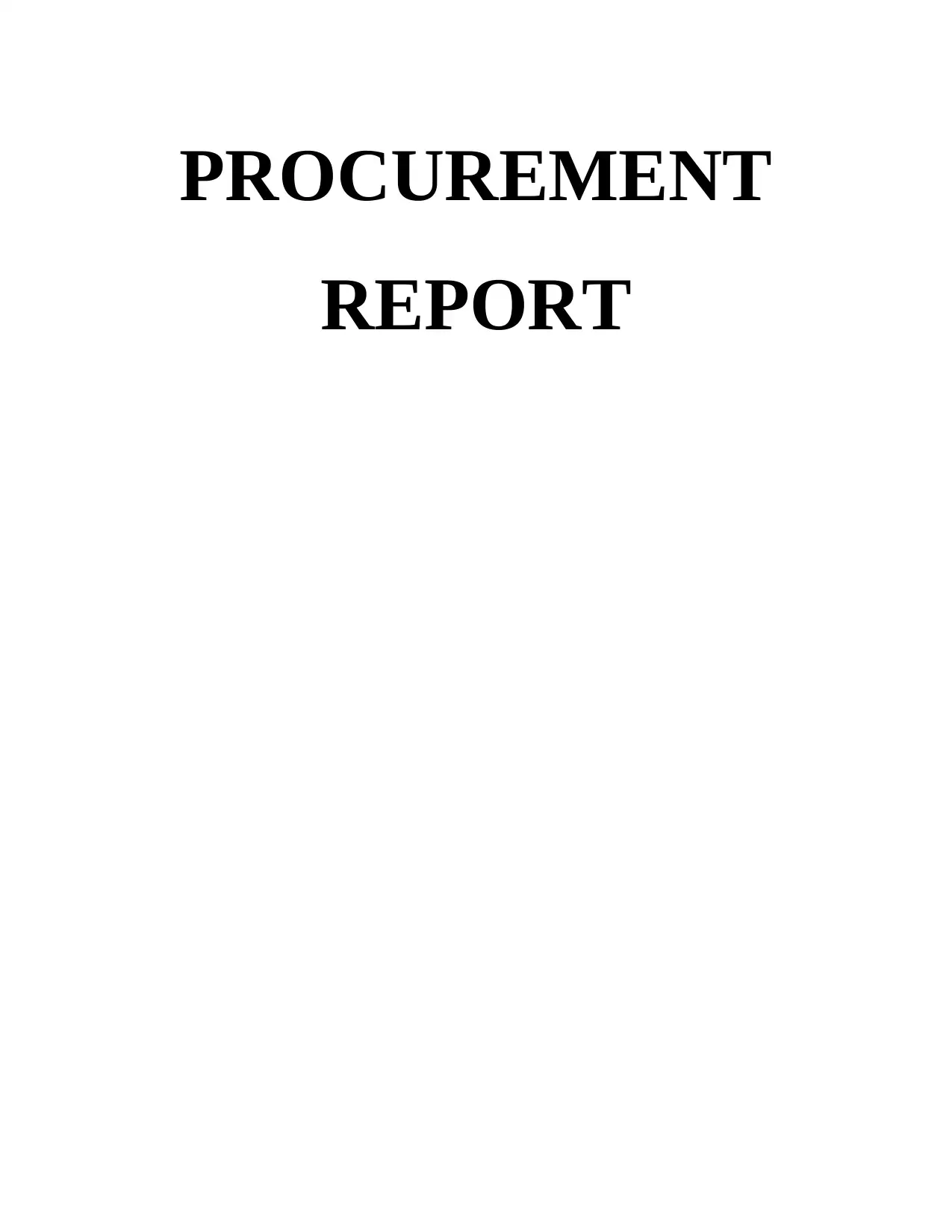
PROCUREMENT
REPORT
REPORT
Paraphrase This Document
Need a fresh take? Get an instant paraphrase of this document with our AI Paraphraser
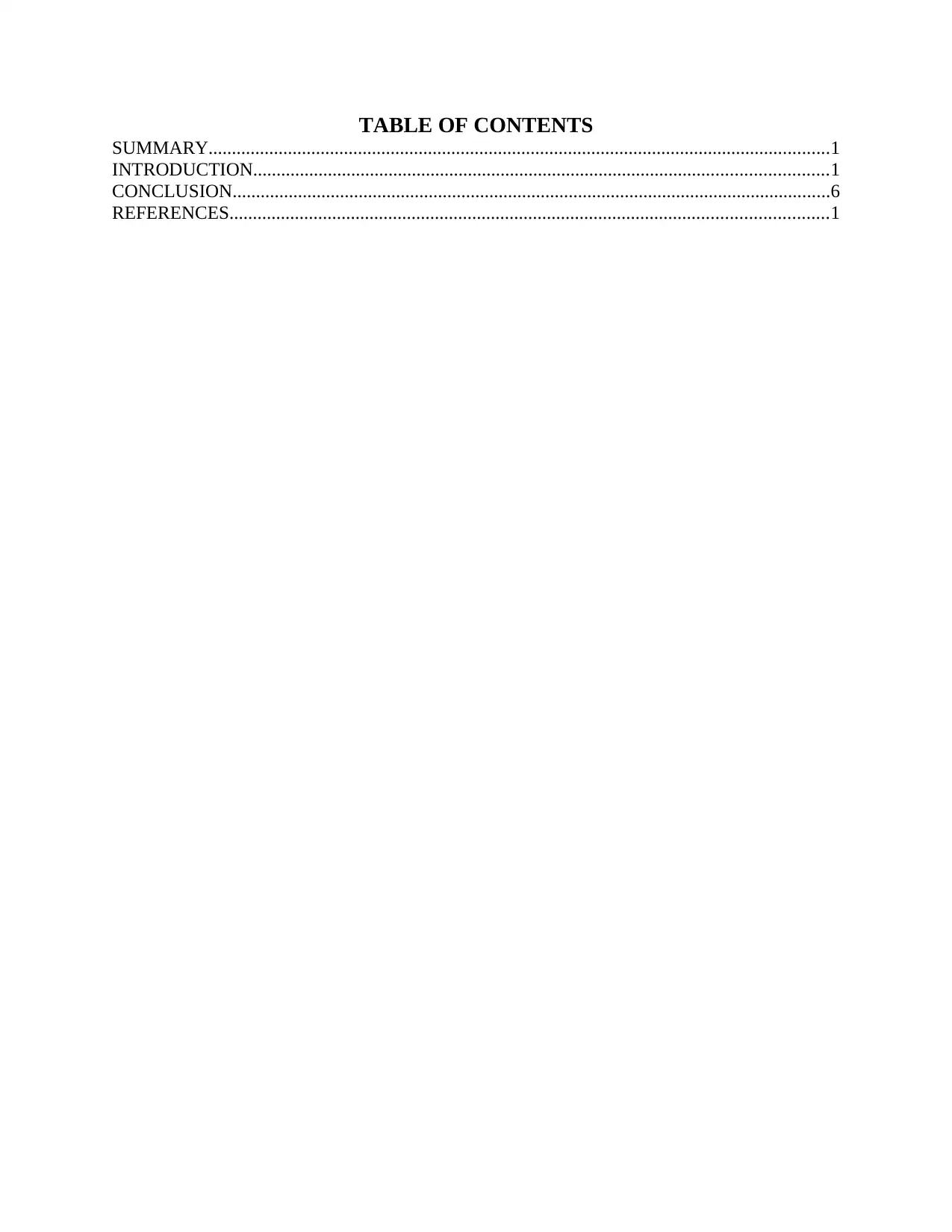
TABLE OF CONTENTS
SUMMARY.....................................................................................................................................1
INTRODUCTION...........................................................................................................................1
CONCLUSION................................................................................................................................6
REFERENCES................................................................................................................................1
SUMMARY.....................................................................................................................................1
INTRODUCTION...........................................................................................................................1
CONCLUSION................................................................................................................................6
REFERENCES................................................................................................................................1
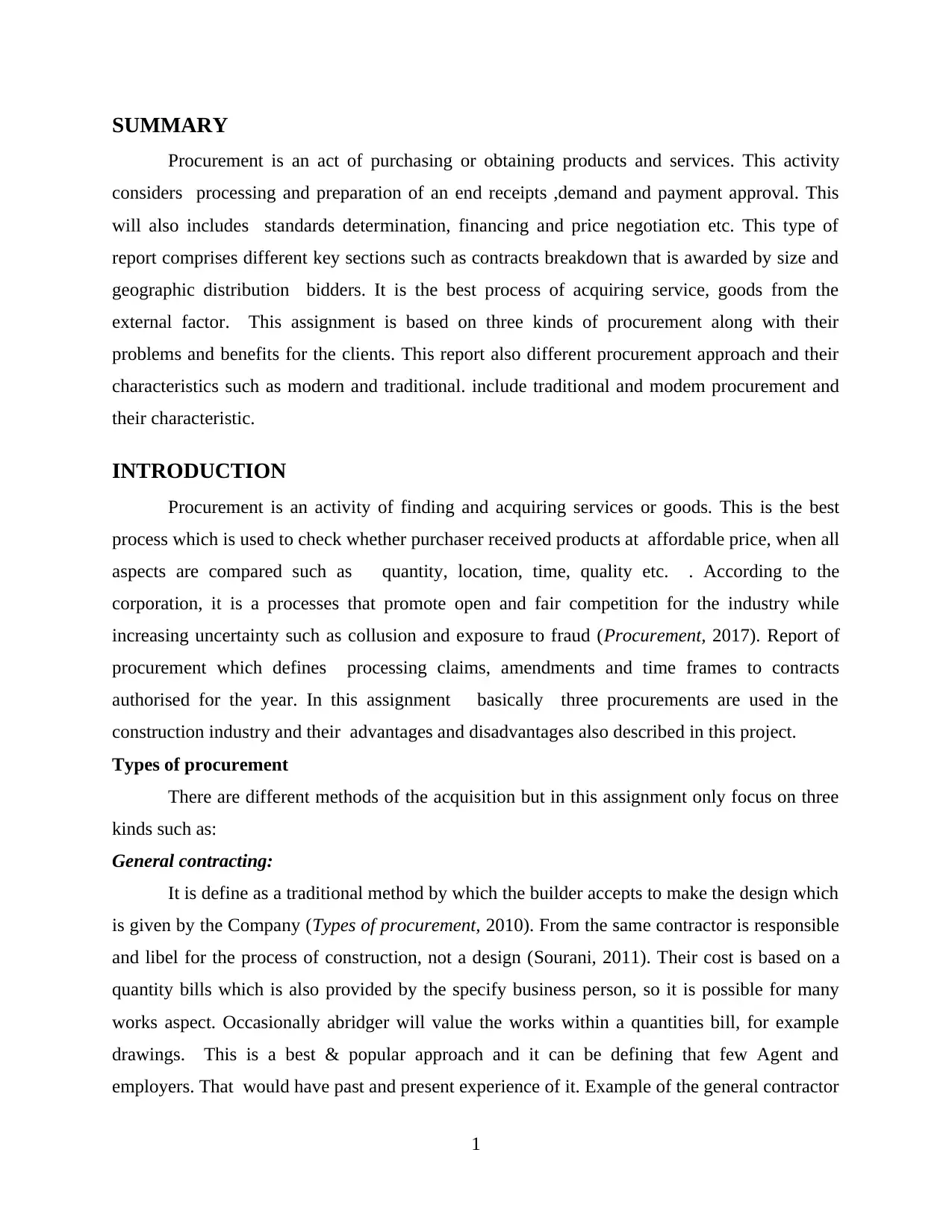
SUMMARY
Procurement is an act of purchasing or obtaining products and services. This activity
considers processing and preparation of an end receipts ,demand and payment approval. This
will also includes standards determination, financing and price negotiation etc. This type of
report comprises different key sections such as contracts breakdown that is awarded by size and
geographic distribution bidders. It is the best process of acquiring service, goods from the
external factor. This assignment is based on three kinds of procurement along with their
problems and benefits for the clients. This report also different procurement approach and their
characteristics such as modern and traditional. include traditional and modem procurement and
their characteristic.
INTRODUCTION
Procurement is an activity of finding and acquiring services or goods. This is the best
process which is used to check whether purchaser received products at affordable price, when all
aspects are compared such as quantity, location, time, quality etc. . According to the
corporation, it is a processes that promote open and fair competition for the industry while
increasing uncertainty such as collusion and exposure to fraud (Procurement, 2017). Report of
procurement which defines processing claims, amendments and time frames to contracts
authorised for the year. In this assignment basically three procurements are used in the
construction industry and their advantages and disadvantages also described in this project.
Types of procurement
There are different methods of the acquisition but in this assignment only focus on three
kinds such as:
General contracting:
It is define as a traditional method by which the builder accepts to make the design which
is given by the Company (Types of procurement, 2010). From the same contractor is responsible
and libel for the process of construction, not a design (Sourani, 2011). Their cost is based on a
quantity bills which is also provided by the specify business person, so it is possible for many
works aspect. Occasionally abridger will value the works within a quantities bill, for example
drawings. This is a best & popular approach and it can be defining that few Agent and
employers. That would have past and present experience of it. Example of the general contractor
1
Procurement is an act of purchasing or obtaining products and services. This activity
considers processing and preparation of an end receipts ,demand and payment approval. This
will also includes standards determination, financing and price negotiation etc. This type of
report comprises different key sections such as contracts breakdown that is awarded by size and
geographic distribution bidders. It is the best process of acquiring service, goods from the
external factor. This assignment is based on three kinds of procurement along with their
problems and benefits for the clients. This report also different procurement approach and their
characteristics such as modern and traditional. include traditional and modem procurement and
their characteristic.
INTRODUCTION
Procurement is an activity of finding and acquiring services or goods. This is the best
process which is used to check whether purchaser received products at affordable price, when all
aspects are compared such as quantity, location, time, quality etc. . According to the
corporation, it is a processes that promote open and fair competition for the industry while
increasing uncertainty such as collusion and exposure to fraud (Procurement, 2017). Report of
procurement which defines processing claims, amendments and time frames to contracts
authorised for the year. In this assignment basically three procurements are used in the
construction industry and their advantages and disadvantages also described in this project.
Types of procurement
There are different methods of the acquisition but in this assignment only focus on three
kinds such as:
General contracting:
It is define as a traditional method by which the builder accepts to make the design which
is given by the Company (Types of procurement, 2010). From the same contractor is responsible
and libel for the process of construction, not a design (Sourani, 2011). Their cost is based on a
quantity bills which is also provided by the specify business person, so it is possible for many
works aspect. Occasionally abridger will value the works within a quantities bill, for example
drawings. This is a best & popular approach and it can be defining that few Agent and
employers. That would have past and present experience of it. Example of the general contractor
1
⊘ This is a preview!⊘
Do you want full access?
Subscribe today to unlock all pages.

Trusted by 1+ million students worldwide
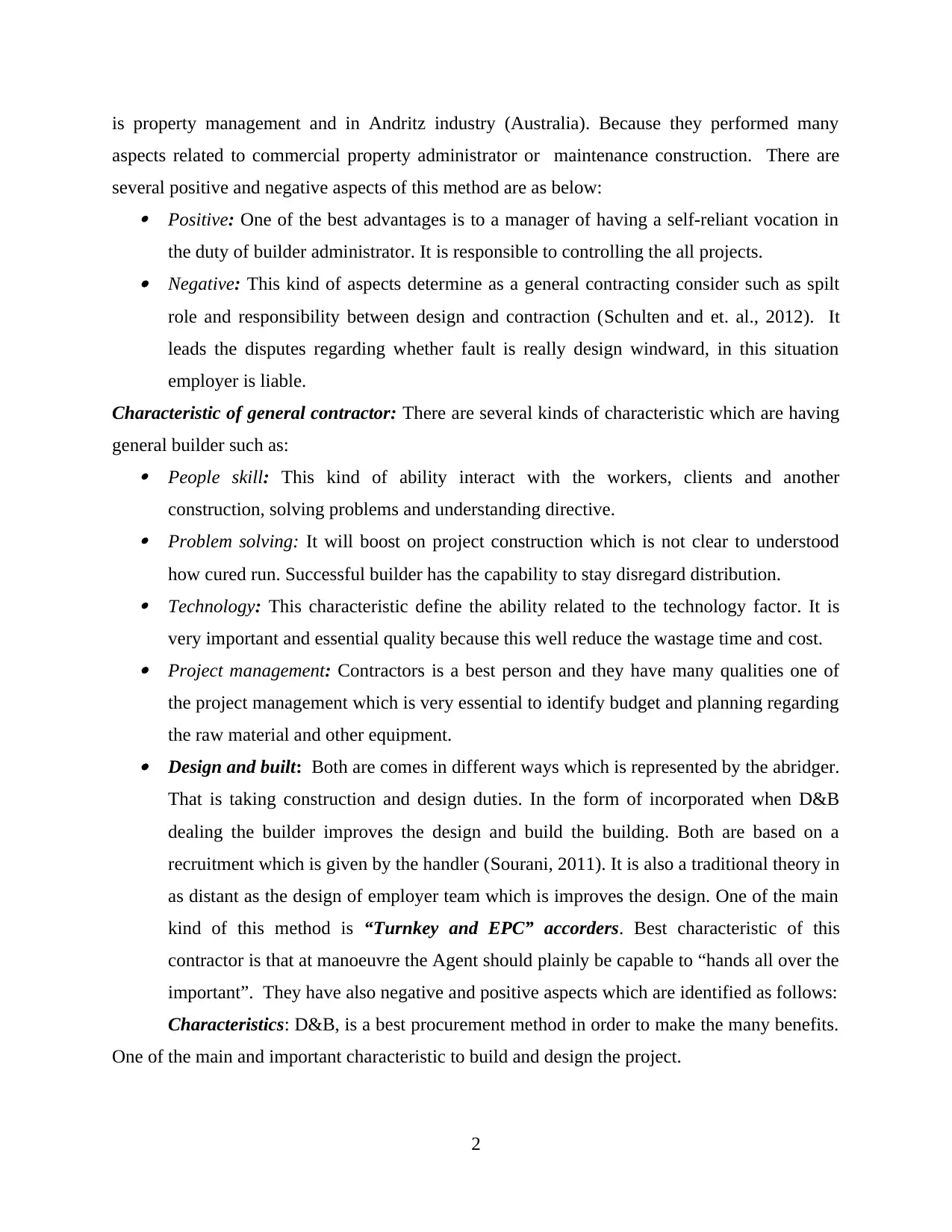
is property management and in Andritz industry (Australia). Because they performed many
aspects related to commercial property administrator or maintenance construction. There are
several positive and negative aspects of this method are as below: Positive: One of the best advantages is to a manager of having a self-reliant vocation in
the duty of builder administrator. It is responsible to controlling the all projects. Negative: This kind of aspects determine as a general contracting consider such as spilt
role and responsibility between design and contraction (Schulten and et. al., 2012). It
leads the disputes regarding whether fault is really design windward, in this situation
employer is liable.
Characteristic of general contractor: There are several kinds of characteristic which are having
general builder such as: People skill: This kind of ability interact with the workers, clients and another
construction, solving problems and understanding directive. Problem solving: It will boost on project construction which is not clear to understood
how cured run. Successful builder has the capability to stay disregard distribution. Technology: This characteristic define the ability related to the technology factor. It is
very important and essential quality because this well reduce the wastage time and cost. Project management: Contractors is a best person and they have many qualities one of
the project management which is very essential to identify budget and planning regarding
the raw material and other equipment. Design and built: Both are comes in different ways which is represented by the abridger.
That is taking construction and design duties. In the form of incorporated when D&B
dealing the builder improves the design and build the building. Both are based on a
recruitment which is given by the handler (Sourani, 2011). It is also a traditional theory in
as distant as the design of employer team which is improves the design. One of the main
kind of this method is “Turnkey and EPC” accorders. Best characteristic of this
contractor is that at manoeuvre the Agent should plainly be capable to “hands all over the
important”. They have also negative and positive aspects which are identified as follows:
Characteristics: D&B, is a best procurement method in order to make the many benefits.
One of the main and important characteristic to build and design the project.
2
aspects related to commercial property administrator or maintenance construction. There are
several positive and negative aspects of this method are as below: Positive: One of the best advantages is to a manager of having a self-reliant vocation in
the duty of builder administrator. It is responsible to controlling the all projects. Negative: This kind of aspects determine as a general contracting consider such as spilt
role and responsibility between design and contraction (Schulten and et. al., 2012). It
leads the disputes regarding whether fault is really design windward, in this situation
employer is liable.
Characteristic of general contractor: There are several kinds of characteristic which are having
general builder such as: People skill: This kind of ability interact with the workers, clients and another
construction, solving problems and understanding directive. Problem solving: It will boost on project construction which is not clear to understood
how cured run. Successful builder has the capability to stay disregard distribution. Technology: This characteristic define the ability related to the technology factor. It is
very important and essential quality because this well reduce the wastage time and cost. Project management: Contractors is a best person and they have many qualities one of
the project management which is very essential to identify budget and planning regarding
the raw material and other equipment. Design and built: Both are comes in different ways which is represented by the abridger.
That is taking construction and design duties. In the form of incorporated when D&B
dealing the builder improves the design and build the building. Both are based on a
recruitment which is given by the handler (Sourani, 2011). It is also a traditional theory in
as distant as the design of employer team which is improves the design. One of the main
kind of this method is “Turnkey and EPC” accorders. Best characteristic of this
contractor is that at manoeuvre the Agent should plainly be capable to “hands all over the
important”. They have also negative and positive aspects which are identified as follows:
Characteristics: D&B, is a best procurement method in order to make the many benefits.
One of the main and important characteristic to build and design the project.
2
Paraphrase This Document
Need a fresh take? Get an instant paraphrase of this document with our AI Paraphraser
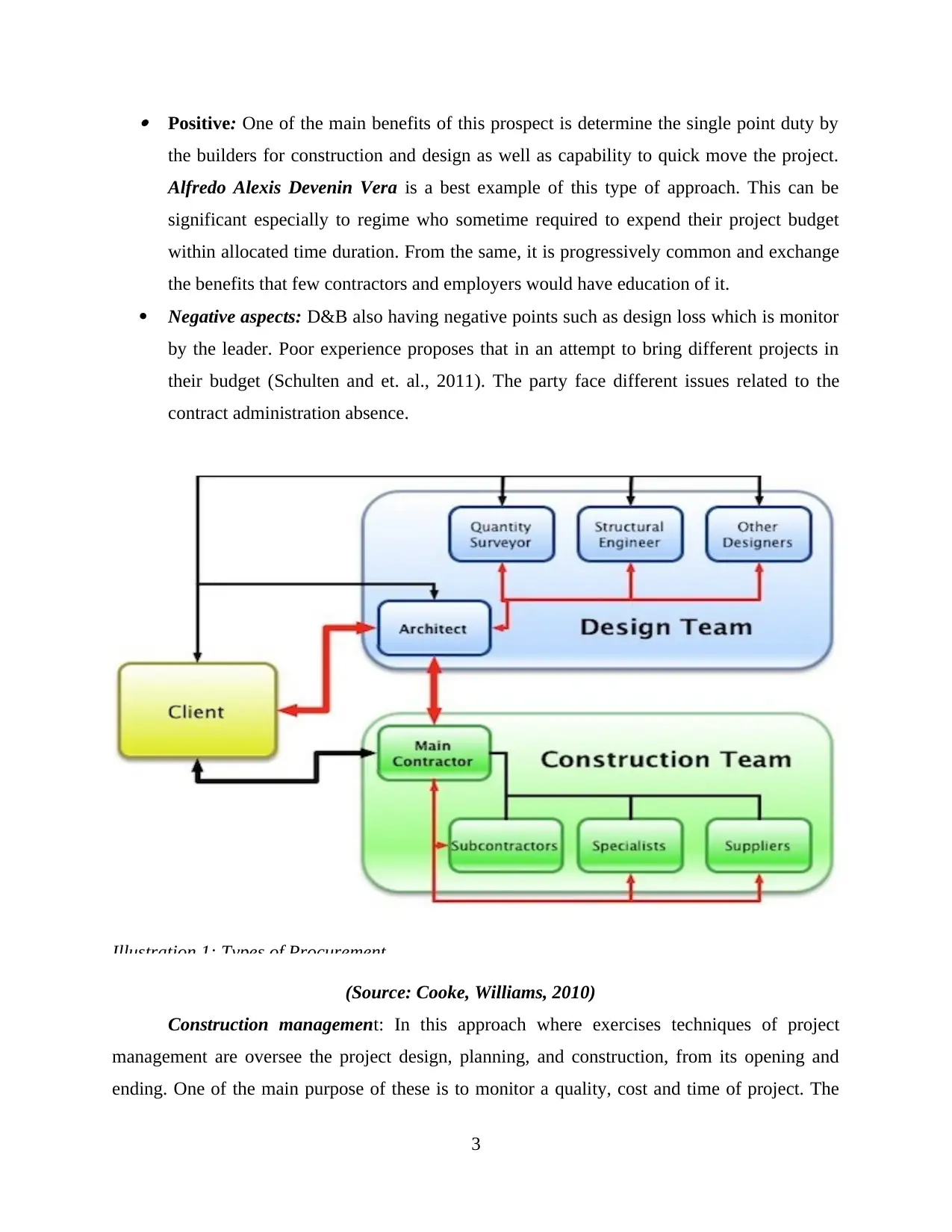
Positive: One of the main benefits of this prospect is determine the single point duty by
the builders for construction and design as well as capability to quick move the project.
Alfredo Alexis Devenin Vera is a best example of this type of approach. This can be
significant especially to regime who sometime required to expend their project budget
within allocated time duration. From the same, it is progressively common and exchange
the benefits that few contractors and employers would have education of it.
Negative aspects: D&B also having negative points such as design loss which is monitor
by the leader. Poor experience proposes that in an attempt to bring different projects in
their budget (Schulten and et. al., 2011). The party face different issues related to the
contract administration absence.
Illustration 1: Types of Procurement
(Source: Cooke, Williams, 2010)
Construction management: In this approach where exercises techniques of project
management are oversee the project design, planning, and construction, from its opening and
ending. One of the main purpose of these is to monitor a quality, cost and time of project. The
3
the builders for construction and design as well as capability to quick move the project.
Alfredo Alexis Devenin Vera is a best example of this type of approach. This can be
significant especially to regime who sometime required to expend their project budget
within allocated time duration. From the same, it is progressively common and exchange
the benefits that few contractors and employers would have education of it.
Negative aspects: D&B also having negative points such as design loss which is monitor
by the leader. Poor experience proposes that in an attempt to bring different projects in
their budget (Schulten and et. al., 2011). The party face different issues related to the
contract administration absence.
Illustration 1: Types of Procurement
(Source: Cooke, Williams, 2010)
Construction management: In this approach where exercises techniques of project
management are oversee the project design, planning, and construction, from its opening and
ending. One of the main purpose of these is to monitor a quality, cost and time of project. The
3
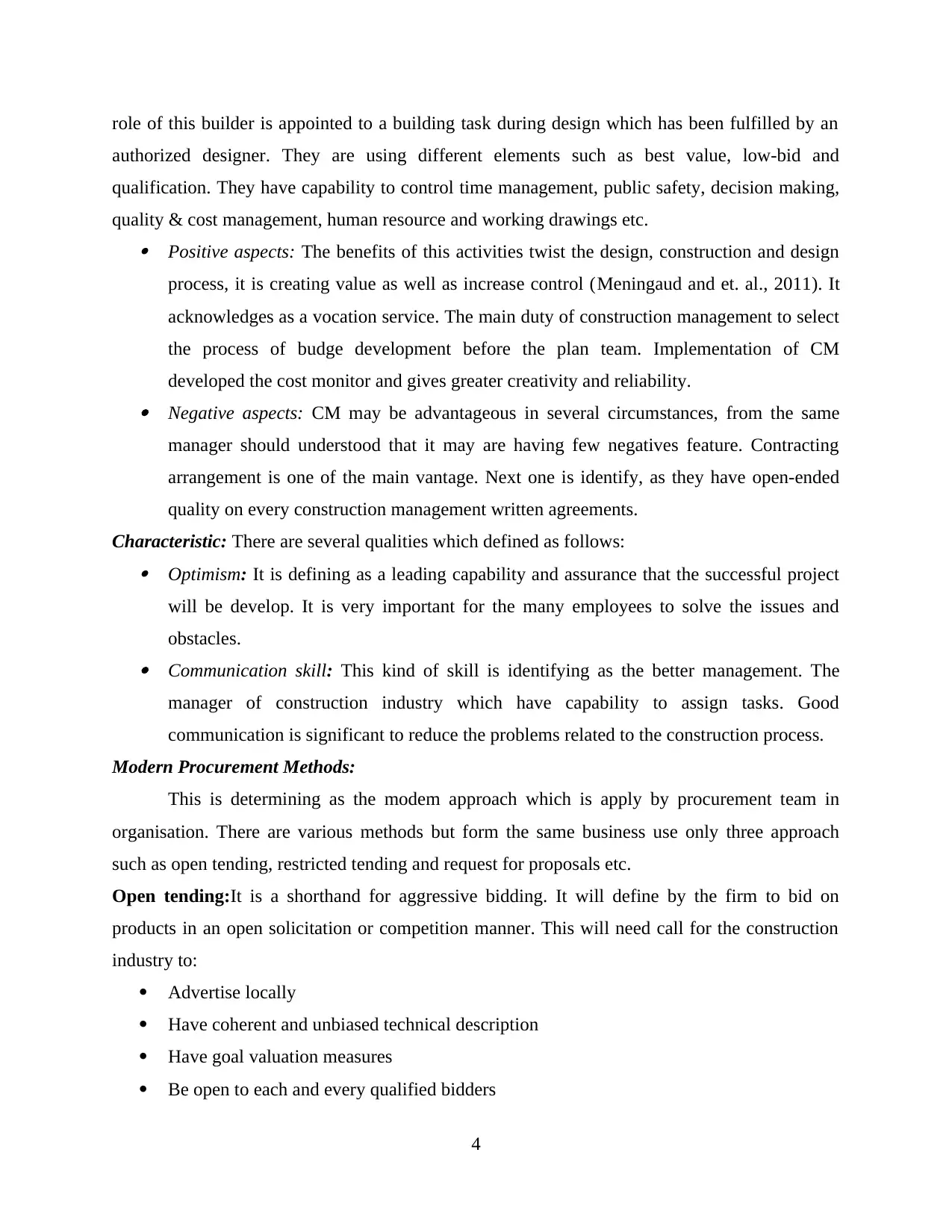
role of this builder is appointed to a building task during design which has been fulfilled by an
authorized designer. They are using different elements such as best value, low-bid and
qualification. They have capability to control time management, public safety, decision making,
quality & cost management, human resource and working drawings etc. Positive aspects: The benefits of this activities twist the design, construction and design
process, it is creating value as well as increase control (Meningaud and et. al., 2011). It
acknowledges as a vocation service. The main duty of construction management to select
the process of budge development before the plan team. Implementation of CM
developed the cost monitor and gives greater creativity and reliability. Negative aspects: CM may be advantageous in several circumstances, from the same
manager should understood that it may are having few negatives feature. Contracting
arrangement is one of the main vantage. Next one is identify, as they have open-ended
quality on every construction management written agreements.
Characteristic: There are several qualities which defined as follows: Optimism: It is defining as a leading capability and assurance that the successful project
will be develop. It is very important for the many employees to solve the issues and
obstacles. Communication skill: This kind of skill is identifying as the better management. The
manager of construction industry which have capability to assign tasks. Good
communication is significant to reduce the problems related to the construction process.
Modern Procurement Methods:
This is determining as the modem approach which is apply by procurement team in
organisation. There are various methods but form the same business use only three approach
such as open tending, restricted tending and request for proposals etc.
Open tending:It is a shorthand for aggressive bidding. It will define by the firm to bid on
products in an open solicitation or competition manner. This will need call for the construction
industry to:
Advertise locally
Have coherent and unbiased technical description
Have goal valuation measures
Be open to each and every qualified bidders
4
authorized designer. They are using different elements such as best value, low-bid and
qualification. They have capability to control time management, public safety, decision making,
quality & cost management, human resource and working drawings etc. Positive aspects: The benefits of this activities twist the design, construction and design
process, it is creating value as well as increase control (Meningaud and et. al., 2011). It
acknowledges as a vocation service. The main duty of construction management to select
the process of budge development before the plan team. Implementation of CM
developed the cost monitor and gives greater creativity and reliability. Negative aspects: CM may be advantageous in several circumstances, from the same
manager should understood that it may are having few negatives feature. Contracting
arrangement is one of the main vantage. Next one is identify, as they have open-ended
quality on every construction management written agreements.
Characteristic: There are several qualities which defined as follows: Optimism: It is defining as a leading capability and assurance that the successful project
will be develop. It is very important for the many employees to solve the issues and
obstacles. Communication skill: This kind of skill is identifying as the better management. The
manager of construction industry which have capability to assign tasks. Good
communication is significant to reduce the problems related to the construction process.
Modern Procurement Methods:
This is determining as the modem approach which is apply by procurement team in
organisation. There are various methods but form the same business use only three approach
such as open tending, restricted tending and request for proposals etc.
Open tending:It is a shorthand for aggressive bidding. It will define by the firm to bid on
products in an open solicitation or competition manner. This will need call for the construction
industry to:
Advertise locally
Have coherent and unbiased technical description
Have goal valuation measures
Be open to each and every qualified bidders
4
⊘ This is a preview!⊘
Do you want full access?
Subscribe today to unlock all pages.

Trusted by 1+ million students worldwide
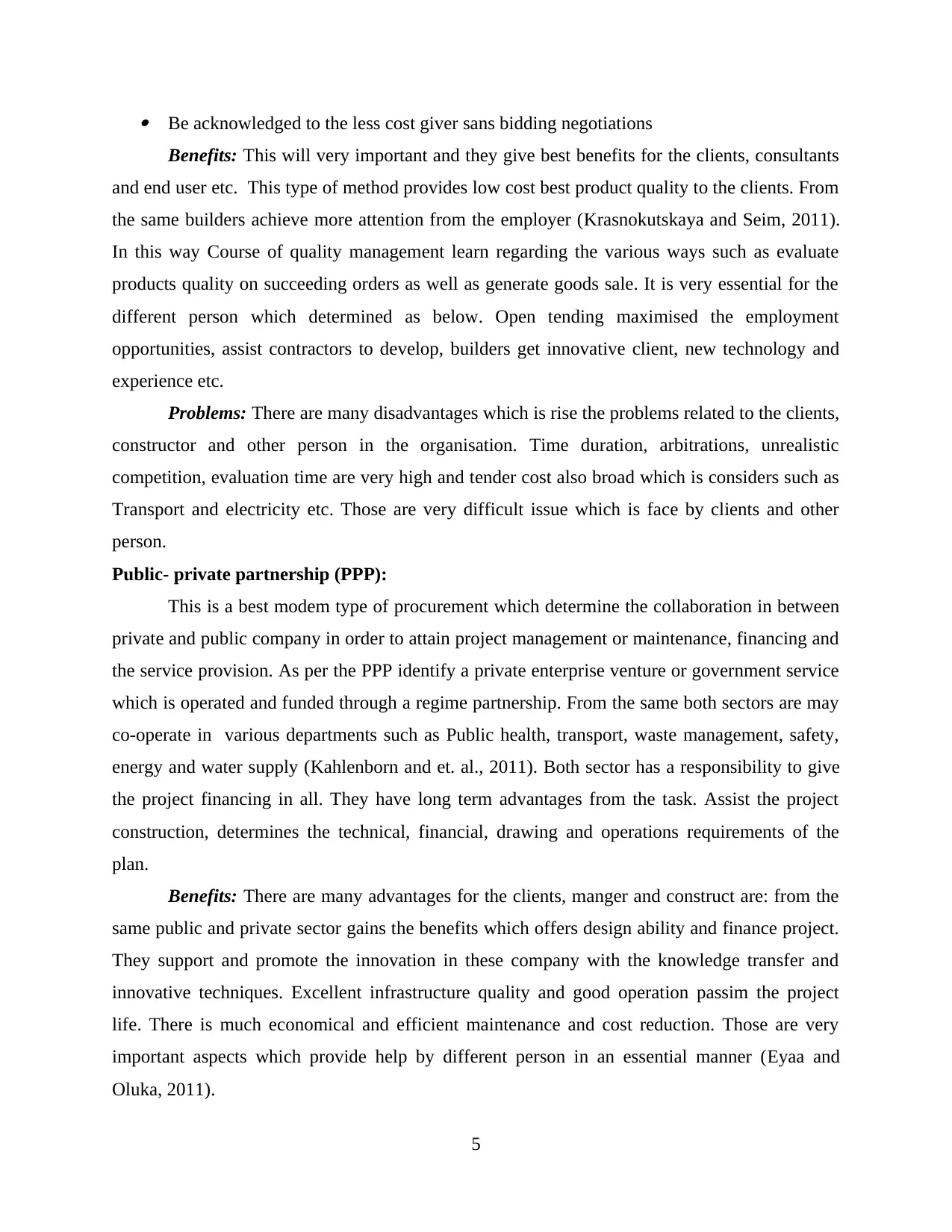
Be acknowledged to the less cost giver sans bidding negotiations
Benefits: This will very important and they give best benefits for the clients, consultants
and end user etc. This type of method provides low cost best product quality to the clients. From
the same builders achieve more attention from the employer (Krasnokutskaya and Seim, 2011).
In this way Course of quality management learn regarding the various ways such as evaluate
products quality on succeeding orders as well as generate goods sale. It is very essential for the
different person which determined as below. Open tending maximised the employment
opportunities, assist contractors to develop, builders get innovative client, new technology and
experience etc.
Problems: There are many disadvantages which is rise the problems related to the clients,
constructor and other person in the organisation. Time duration, arbitrations, unrealistic
competition, evaluation time are very high and tender cost also broad which is considers such as
Transport and electricity etc. Those are very difficult issue which is face by clients and other
person.
Public- private partnership (PPP):
This is a best modem type of procurement which determine the collaboration in between
private and public company in order to attain project management or maintenance, financing and
the service provision. As per the PPP identify a private enterprise venture or government service
which is operated and funded through a regime partnership. From the same both sectors are may
co-operate in various departments such as Public health, transport, waste management, safety,
energy and water supply (Kahlenborn and et. al., 2011). Both sector has a responsibility to give
the project financing in all. They have long term advantages from the task. Assist the project
construction, determines the technical, financial, drawing and operations requirements of the
plan.
Benefits: There are many advantages for the clients, manger and construct are: from the
same public and private sector gains the benefits which offers design ability and finance project.
They support and promote the innovation in these company with the knowledge transfer and
innovative techniques. Excellent infrastructure quality and good operation passim the project
life. There is much economical and efficient maintenance and cost reduction. Those are very
important aspects which provide help by different person in an essential manner (Eyaa and
Oluka, 2011).
5
Benefits: This will very important and they give best benefits for the clients, consultants
and end user etc. This type of method provides low cost best product quality to the clients. From
the same builders achieve more attention from the employer (Krasnokutskaya and Seim, 2011).
In this way Course of quality management learn regarding the various ways such as evaluate
products quality on succeeding orders as well as generate goods sale. It is very essential for the
different person which determined as below. Open tending maximised the employment
opportunities, assist contractors to develop, builders get innovative client, new technology and
experience etc.
Problems: There are many disadvantages which is rise the problems related to the clients,
constructor and other person in the organisation. Time duration, arbitrations, unrealistic
competition, evaluation time are very high and tender cost also broad which is considers such as
Transport and electricity etc. Those are very difficult issue which is face by clients and other
person.
Public- private partnership (PPP):
This is a best modem type of procurement which determine the collaboration in between
private and public company in order to attain project management or maintenance, financing and
the service provision. As per the PPP identify a private enterprise venture or government service
which is operated and funded through a regime partnership. From the same both sectors are may
co-operate in various departments such as Public health, transport, waste management, safety,
energy and water supply (Kahlenborn and et. al., 2011). Both sector has a responsibility to give
the project financing in all. They have long term advantages from the task. Assist the project
construction, determines the technical, financial, drawing and operations requirements of the
plan.
Benefits: There are many advantages for the clients, manger and construct are: from the
same public and private sector gains the benefits which offers design ability and finance project.
They support and promote the innovation in these company with the knowledge transfer and
innovative techniques. Excellent infrastructure quality and good operation passim the project
life. There is much economical and efficient maintenance and cost reduction. Those are very
important aspects which provide help by different person in an essential manner (Eyaa and
Oluka, 2011).
5
Paraphrase This Document
Need a fresh take? Get an instant paraphrase of this document with our AI Paraphraser
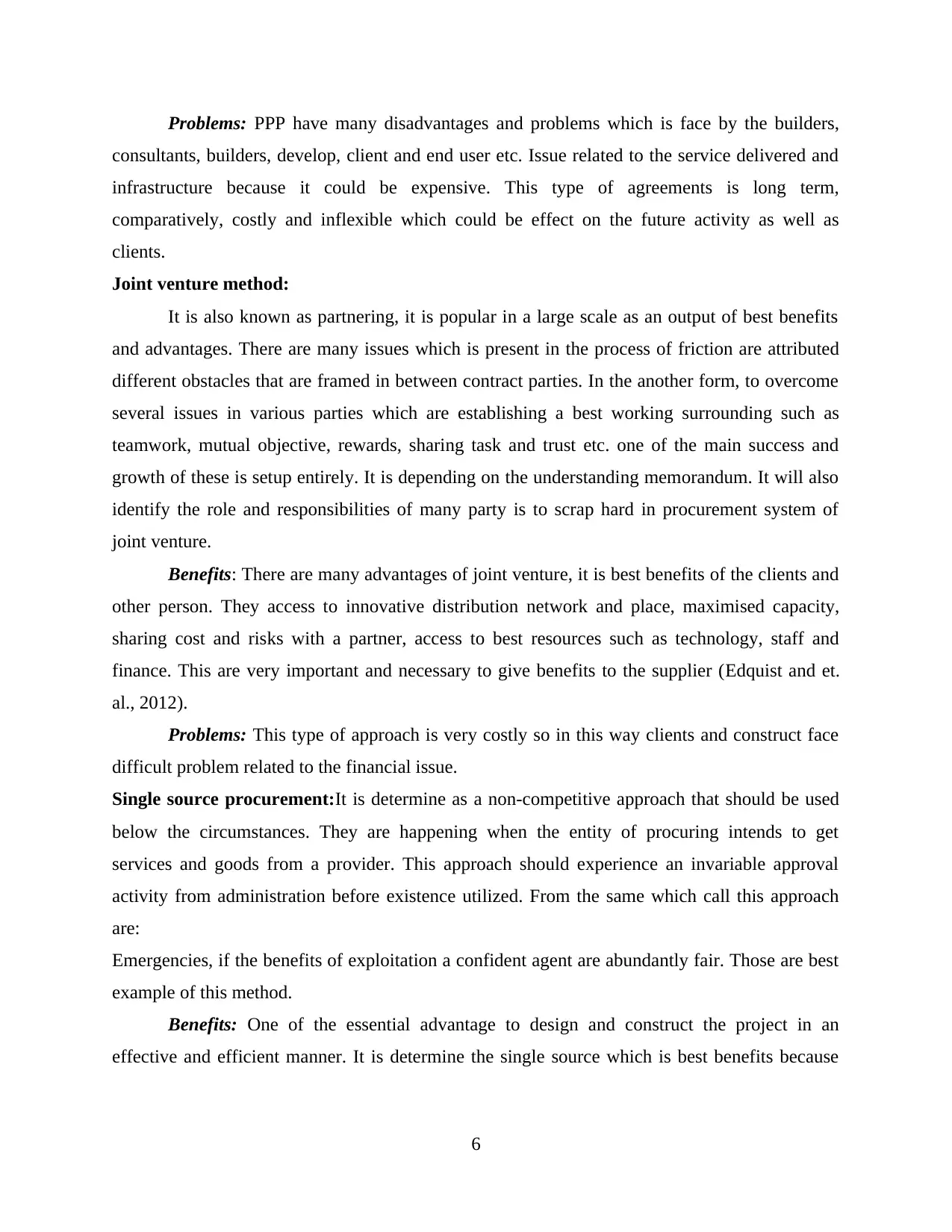
Problems: PPP have many disadvantages and problems which is face by the builders,
consultants, builders, develop, client and end user etc. Issue related to the service delivered and
infrastructure because it could be expensive. This type of agreements is long term,
comparatively, costly and inflexible which could be effect on the future activity as well as
clients.
Joint venture method:
It is also known as partnering, it is popular in a large scale as an output of best benefits
and advantages. There are many issues which is present in the process of friction are attributed
different obstacles that are framed in between contract parties. In the another form, to overcome
several issues in various parties which are establishing a best working surrounding such as
teamwork, mutual objective, rewards, sharing task and trust etc. one of the main success and
growth of these is setup entirely. It is depending on the understanding memorandum. It will also
identify the role and responsibilities of many party is to scrap hard in procurement system of
joint venture.
Benefits: There are many advantages of joint venture, it is best benefits of the clients and
other person. They access to innovative distribution network and place, maximised capacity,
sharing cost and risks with a partner, access to best resources such as technology, staff and
finance. This are very important and necessary to give benefits to the supplier (Edquist and et.
al., 2012).
Problems: This type of approach is very costly so in this way clients and construct face
difficult problem related to the financial issue.
Single source procurement:It is determine as a non-competitive approach that should be used
below the circumstances. They are happening when the entity of procuring intends to get
services and goods from a provider. This approach should experience an invariable approval
activity from administration before existence utilized. From the same which call this approach
are:
Emergencies, if the benefits of exploitation a confident agent are abundantly fair. Those are best
example of this method.
Benefits: One of the essential advantage to design and construct the project in an
effective and efficient manner. It is determine the single source which is best benefits because
6
consultants, builders, develop, client and end user etc. Issue related to the service delivered and
infrastructure because it could be expensive. This type of agreements is long term,
comparatively, costly and inflexible which could be effect on the future activity as well as
clients.
Joint venture method:
It is also known as partnering, it is popular in a large scale as an output of best benefits
and advantages. There are many issues which is present in the process of friction are attributed
different obstacles that are framed in between contract parties. In the another form, to overcome
several issues in various parties which are establishing a best working surrounding such as
teamwork, mutual objective, rewards, sharing task and trust etc. one of the main success and
growth of these is setup entirely. It is depending on the understanding memorandum. It will also
identify the role and responsibilities of many party is to scrap hard in procurement system of
joint venture.
Benefits: There are many advantages of joint venture, it is best benefits of the clients and
other person. They access to innovative distribution network and place, maximised capacity,
sharing cost and risks with a partner, access to best resources such as technology, staff and
finance. This are very important and necessary to give benefits to the supplier (Edquist and et.
al., 2012).
Problems: This type of approach is very costly so in this way clients and construct face
difficult problem related to the financial issue.
Single source procurement:It is determine as a non-competitive approach that should be used
below the circumstances. They are happening when the entity of procuring intends to get
services and goods from a provider. This approach should experience an invariable approval
activity from administration before existence utilized. From the same which call this approach
are:
Emergencies, if the benefits of exploitation a confident agent are abundantly fair. Those are best
example of this method.
Benefits: One of the essential advantage to design and construct the project in an
effective and efficient manner. It is determine the single source which is best benefits because
6
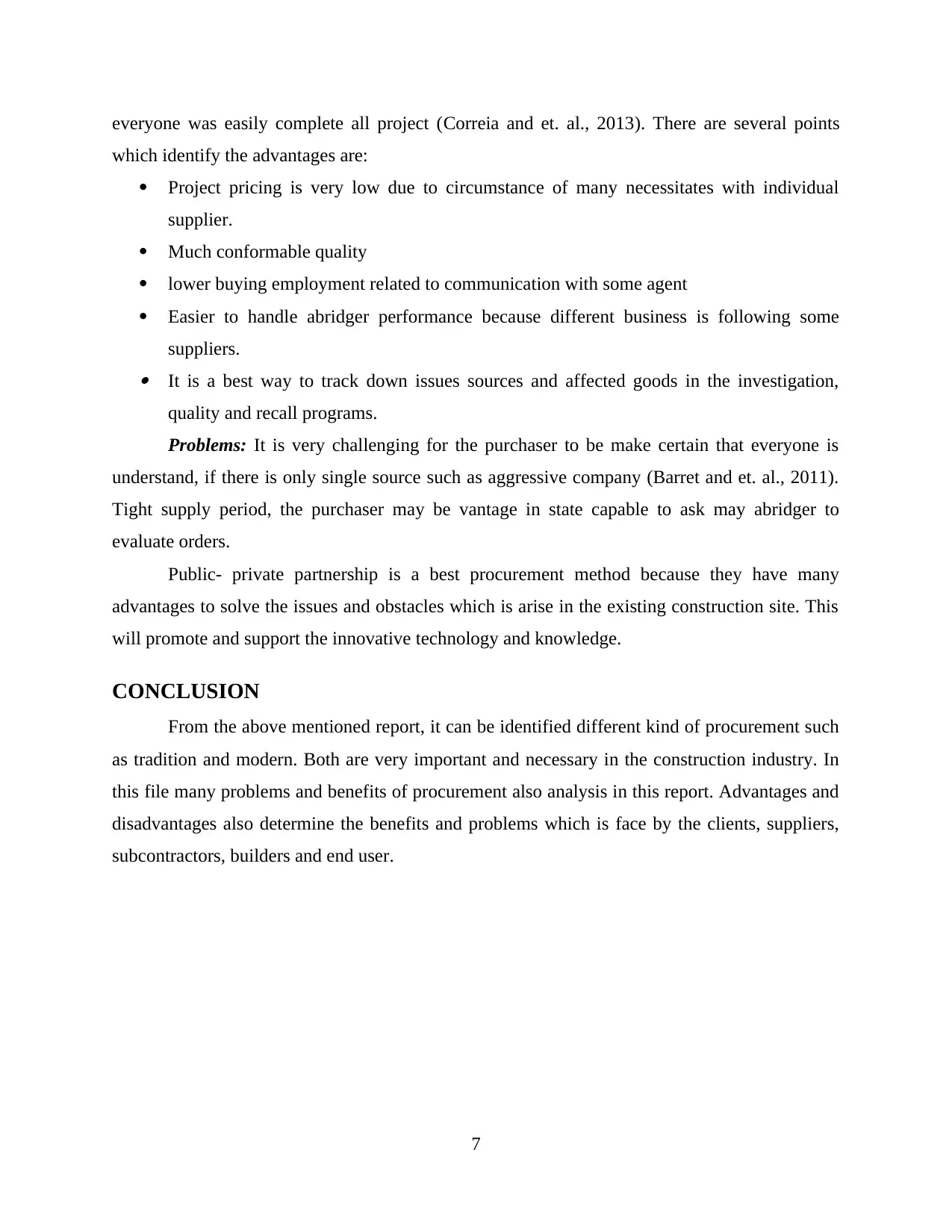
everyone was easily complete all project (Correia and et. al., 2013). There are several points
which identify the advantages are:
Project pricing is very low due to circumstance of many necessitates with individual
supplier.
Much conformable quality
lower buying employment related to communication with some agent
Easier to handle abridger performance because different business is following some
suppliers. It is a best way to track down issues sources and affected goods in the investigation,
quality and recall programs.
Problems: It is very challenging for the purchaser to be make certain that everyone is
understand, if there is only single source such as aggressive company (Barret and et. al., 2011).
Tight supply period, the purchaser may be vantage in state capable to ask may abridger to
evaluate orders.
Public- private partnership is a best procurement method because they have many
advantages to solve the issues and obstacles which is arise in the existing construction site. This
will promote and support the innovative technology and knowledge.
CONCLUSION
From the above mentioned report, it can be identified different kind of procurement such
as tradition and modern. Both are very important and necessary in the construction industry. In
this file many problems and benefits of procurement also analysis in this report. Advantages and
disadvantages also determine the benefits and problems which is face by the clients, suppliers,
subcontractors, builders and end user.
7
which identify the advantages are:
Project pricing is very low due to circumstance of many necessitates with individual
supplier.
Much conformable quality
lower buying employment related to communication with some agent
Easier to handle abridger performance because different business is following some
suppliers. It is a best way to track down issues sources and affected goods in the investigation,
quality and recall programs.
Problems: It is very challenging for the purchaser to be make certain that everyone is
understand, if there is only single source such as aggressive company (Barret and et. al., 2011).
Tight supply period, the purchaser may be vantage in state capable to ask may abridger to
evaluate orders.
Public- private partnership is a best procurement method because they have many
advantages to solve the issues and obstacles which is arise in the existing construction site. This
will promote and support the innovative technology and knowledge.
CONCLUSION
From the above mentioned report, it can be identified different kind of procurement such
as tradition and modern. Both are very important and necessary in the construction industry. In
this file many problems and benefits of procurement also analysis in this report. Advantages and
disadvantages also determine the benefits and problems which is face by the clients, suppliers,
subcontractors, builders and end user.
7
⊘ This is a preview!⊘
Do you want full access?
Subscribe today to unlock all pages.

Trusted by 1+ million students worldwide
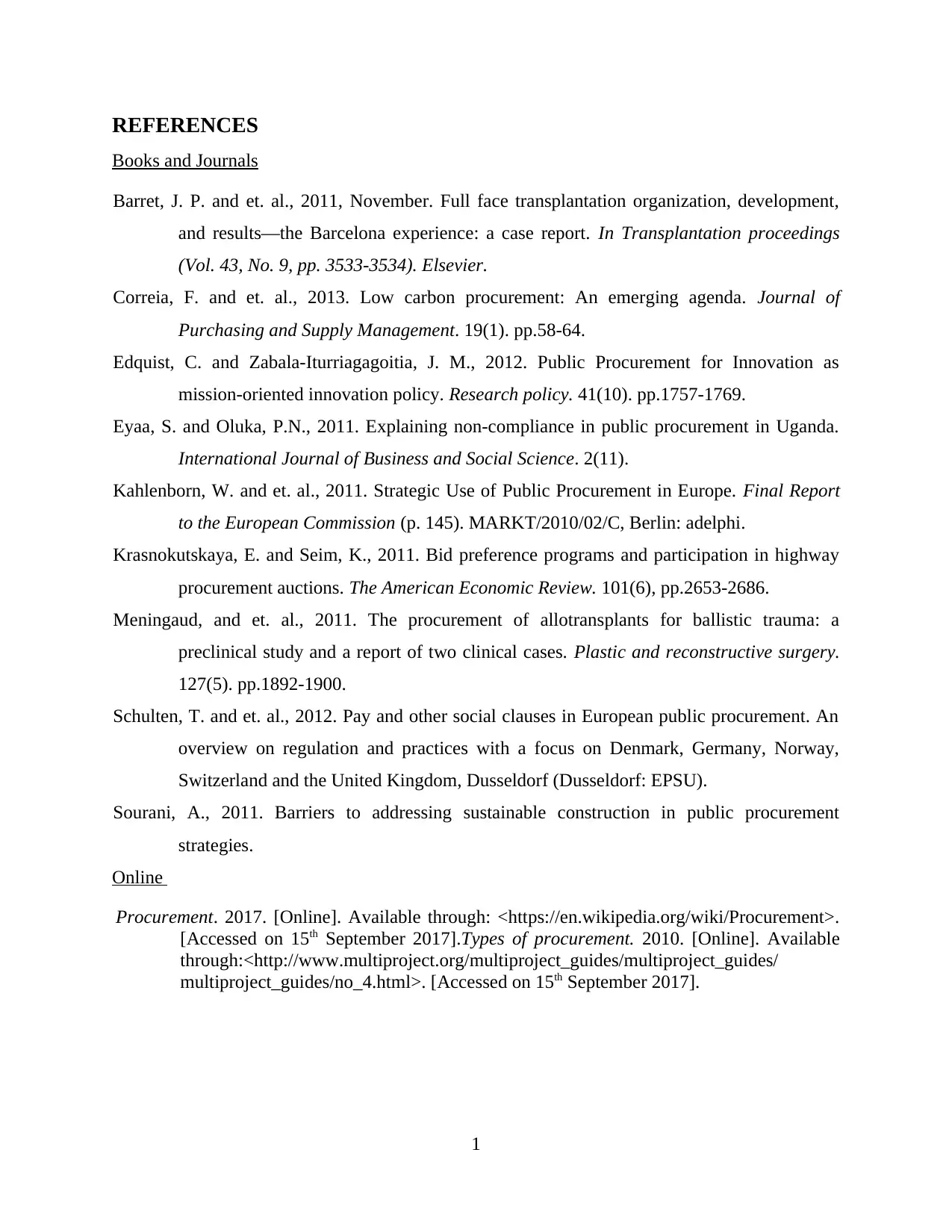
REFERENCES
Books and Journals
Barret, J. P. and et. al., 2011, November. Full face transplantation organization, development,
and results—the Barcelona experience: a case report. In Transplantation proceedings
(Vol. 43, No. 9, pp. 3533-3534). Elsevier.
Correia, F. and et. al., 2013. Low carbon procurement: An emerging agenda. Journal of
Purchasing and Supply Management. 19(1). pp.58-64.
Edquist, C. and Zabala-Iturriagagoitia, J. M., 2012. Public Procurement for Innovation as
mission-oriented innovation policy. Research policy. 41(10). pp.1757-1769.
Eyaa, S. and Oluka, P.N., 2011. Explaining non-compliance in public procurement in Uganda.
International Journal of Business and Social Science. 2(11).
Kahlenborn, W. and et. al., 2011. Strategic Use of Public Procurement in Europe. Final Report
to the European Commission (p. 145). MARKT/2010/02/C, Berlin: adelphi.
Krasnokutskaya, E. and Seim, K., 2011. Bid preference programs and participation in highway
procurement auctions. The American Economic Review. 101(6), pp.2653-2686.
Meningaud, and et. al., 2011. The procurement of allotransplants for ballistic trauma: a
preclinical study and a report of two clinical cases. Plastic and reconstructive surgery.
127(5). pp.1892-1900.
Schulten, T. and et. al., 2012. Pay and other social clauses in European public procurement. An
overview on regulation and practices with a focus on Denmark, Germany, Norway,
Switzerland and the United Kingdom, Dusseldorf (Dusseldorf: EPSU).
Sourani, A., 2011. Barriers to addressing sustainable construction in public procurement
strategies.
Online
Procurement. 2017. [Online]. Available through: <https://en.wikipedia.org/wiki/Procurement>.
[Accessed on 15th September 2017].Types of procurement. 2010. [Online]. Available
through:<http://www.multiproject.org/multiproject_guides/multiproject_guides/
multiproject_guides/no_4.html>. [Accessed on 15th September 2017].
1
Books and Journals
Barret, J. P. and et. al., 2011, November. Full face transplantation organization, development,
and results—the Barcelona experience: a case report. In Transplantation proceedings
(Vol. 43, No. 9, pp. 3533-3534). Elsevier.
Correia, F. and et. al., 2013. Low carbon procurement: An emerging agenda. Journal of
Purchasing and Supply Management. 19(1). pp.58-64.
Edquist, C. and Zabala-Iturriagagoitia, J. M., 2012. Public Procurement for Innovation as
mission-oriented innovation policy. Research policy. 41(10). pp.1757-1769.
Eyaa, S. and Oluka, P.N., 2011. Explaining non-compliance in public procurement in Uganda.
International Journal of Business and Social Science. 2(11).
Kahlenborn, W. and et. al., 2011. Strategic Use of Public Procurement in Europe. Final Report
to the European Commission (p. 145). MARKT/2010/02/C, Berlin: adelphi.
Krasnokutskaya, E. and Seim, K., 2011. Bid preference programs and participation in highway
procurement auctions. The American Economic Review. 101(6), pp.2653-2686.
Meningaud, and et. al., 2011. The procurement of allotransplants for ballistic trauma: a
preclinical study and a report of two clinical cases. Plastic and reconstructive surgery.
127(5). pp.1892-1900.
Schulten, T. and et. al., 2012. Pay and other social clauses in European public procurement. An
overview on regulation and practices with a focus on Denmark, Germany, Norway,
Switzerland and the United Kingdom, Dusseldorf (Dusseldorf: EPSU).
Sourani, A., 2011. Barriers to addressing sustainable construction in public procurement
strategies.
Online
Procurement. 2017. [Online]. Available through: <https://en.wikipedia.org/wiki/Procurement>.
[Accessed on 15th September 2017].Types of procurement. 2010. [Online]. Available
through:<http://www.multiproject.org/multiproject_guides/multiproject_guides/
multiproject_guides/no_4.html>. [Accessed on 15th September 2017].
1
1 out of 10
Related Documents
Your All-in-One AI-Powered Toolkit for Academic Success.
+13062052269
info@desklib.com
Available 24*7 on WhatsApp / Email
![[object Object]](/_next/static/media/star-bottom.7253800d.svg)
Unlock your academic potential
Copyright © 2020–2025 A2Z Services. All Rights Reserved. Developed and managed by ZUCOL.




